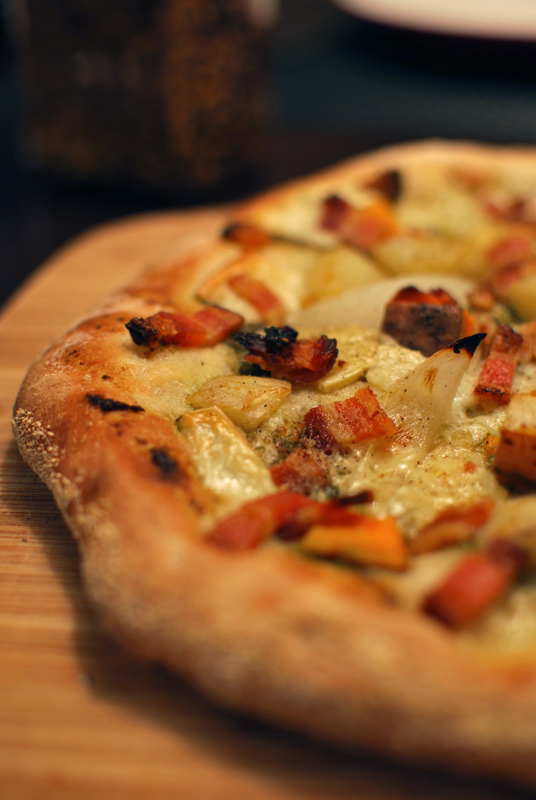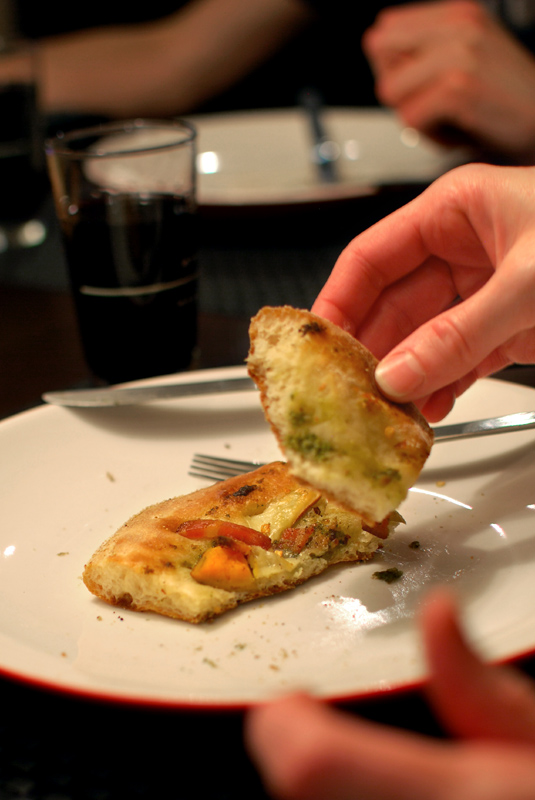Week Forty-Six: Professional Recipes
I never used to think much about pizza. I didn’t dislike it, but I didn’t particularly love it either. Of course, growing up, my pizza experience was limited to the major chains, so you can’t really blame me. Eventually, I tried better pizzas, and started to understand the appeal; but the turning point for me came just a few years ago.
My boyfriend, while we were still a-courtin’, took me to a pizza place one night. He had been there once before, and assured me (his gourmet-food-lovin’ girl) that I would enjoy a pizza like no other. The chef had trained in Italy (Naples, to be exact), and had flown in materials and workers to build his oven, which heats to 1200° F and cooks pizzas in 90 seconds flat. It was said to be the most authentic Napoli-style pizza available, short of hopping on a plane.
There, I tasted what must be Plato’s Ideal Pizza: lightly charred in spots on the outside, moist and almost wet in the middle, with possibly the world’s most addictive gluten-pull to the crust. Properly dressed with a restrained hand, the crust was the star of the show, despite the four-star toppings. And lo, my eyes were opened, and I began to understand why people ever ate pizza to begin with. To this day, I still crave the chew and creamy texture of that pizza from time to time; luckily, I live in the general vicinity of this restaurant.
But as much as I adore it, it’s not always possible to indulge in such luxury. Sometimes, I need a homemade substitute, but I’m rarely willing to compromise quality. It’s not pizza I crave, it’s that perfect texture. And unfortunately, even if I did get the recipe for that particular crust, it’s not a matter of any combination of ingredients; it’s that insanely hot oven that really makes it happen.
So when I found a home-kitchen-ready recipe for pizza crust from Pizzeria Bianco, a highly vaunted pizza restaurant in Arizona, I had to try it. Not that I’ve ever been to Pizzeria Bianco, but if the New York Times calls a place in Phoenix “pizza Nirvana“, it’s got to be at least half-decent.
In the absence of a 1200° F oven, I wasn’t expecting quite the same level of eye-rolling goodness; but 550° F and a quality pizza stone gave me enough confidence to try it. The dough was very supple and forgiving, to the point that I stretched it out a bit more thinly than I usually prefer, resulting in a texture that was more crisp than chewy.
But overall, the result was quite good. The flavor of the dough was well-balanced, with the lightest touch of sweetness from the honey that I always choose to add to my crusts. If the dough were allowed to rise in the refrigerator overnight, the flavor would be more complex as a result, but it’s not necessary in this case. It has an appropriately uneven crumb, with the occasional appearance of a giant bubble at the edge.
Unfortunately, this isn’t precisely the pizza of my dreams, but I’m reasonably sure that is a pipe dream until I build myself a volcanic stone wood-burning oven in the backyard (that I don’t have). Until then, there’s always that other restaurant, or this recipe and my baking stone, and that’s close enough for me.
Pizza Crust
Adapted from Pizzeria Bianco, Phoenix, AZ
Makes one 14 inch pizza, to serve 2 to 3
8 ounces (about 1 3/4 cups) unbleached all-purpose flour, divided, plus extra for dusting
2 teaspoons instant yeast
1 teaspoon salt
3/4 cup water, at room temperature
2 teaspoons olive oil
2 teaspoons honey (optional)
Cornmeal or semolina, for dusting
1. In the bowl of a stand mixer, whisk together the flour, yeast, and salt. Add the water, olive oil, and honey (if using). Using the dough hook, mix at low speed until combined. Turn the mixer off. Without removing the bowl or hook, cover loosely with plastic wrap and let rest for 10 to 20 minutes.
2. Remove the plastic wrap. Turn the speed to medium-low, and continue kneading until smooth and elastic, 5 to 6 minutes. Dough will be very slack, and will not clear the sides of the bowl. If needed, add additional flour or to correct the consistency.
3. Tranfer the dough to a large, lightly oiled bowl. Dust with flour, and cover with plastic wrap or a damp kitchen towel (not terry cloth). Let rise at room temperature until doubled in size, about 75 minutes.
4. While the dough rises, prepare any desired toppings. At least 45 minutes before baking the pizza, put a baking stone on an oven rack in the lower third of the oven, and preheat oven to 550° F. If you don’t have a stone, you can use a large baking sheet turned upside-down.
5. Place a piece of parchment paper on a pizza peel, or on an unrimmed baking sheet. Dust liberally with cornmeal or semolina. Dust the dough with flour, then turn out onto the prepared parchment, taking care not to deflate. Pat out the dough evenly with your fingers and gently stretch into a round, reflouring fingers if necessary. Spread dough with desired toppings, leaving a 1 inch border.
6. Slide pizza, still on parchment, from the peel onto the preheated stone. Bake at 550° F until the dough is golden brown, about 5 to 8 minutes. Using the peel, transfer the pizza to a cutting board, discarding the parchment. Cool 5 minutes before slicing.
Notes:
1. Dough can be allowed to rise slowly in the refrigerator for 1 day. Bring to room temperature for about 1 hour before shaping.




Hi there, I just tried the fermented overnight bread last night and it turned out great. Thanks. The restaurant that you we’re talking about, is it “Famoso”? The story sounds like the chain that we have around here.
Cheers
Steve